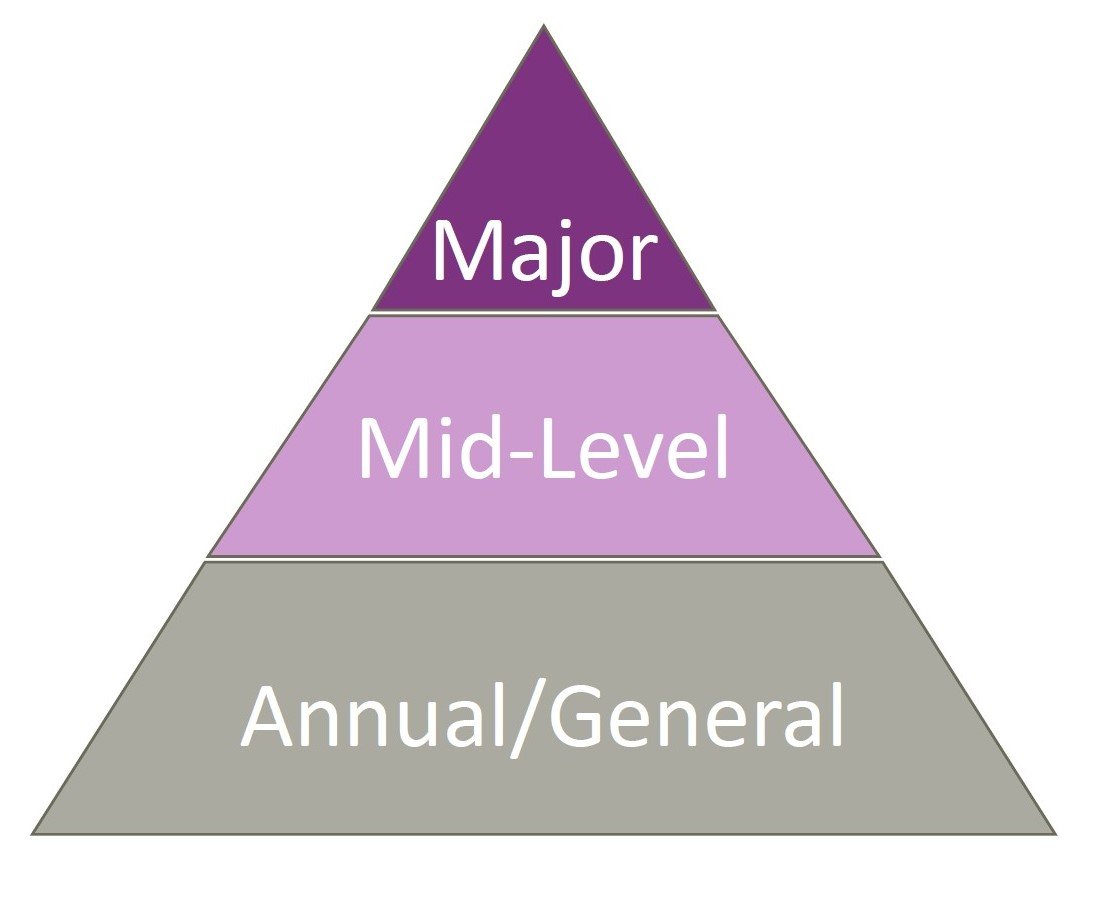Be Aware. Be Intentional. Be Real.
Every good fundraiser dreams about the donor pyramid.
Or, maybe it is the thing of nightmares.
The nagging thought that keeps us up at night.
Am I motivating my general donors — the large group at the base of the pyramid — to upgrade their giving? Are they compelled by the Mission’s work and community impact to increase their connectivity and give more on an annual basis? Do they have capacity to give more than $1,000 annually? If so, how can I connect with them to tell the story?
There are a few things that can point you toward success.
Be aware.
As a Development professional, you should understand your donor file. You should know how many individuals are giving at different levels and what percentage of your annual income is coming from each audience.
Mid-Level and major donors are valuable. Generally a small percentage of the total donor file provides a large percentage of annual revenue. Think Pareto Principle (the 80/20 rule). It holds true in terms of nonprofit donors just as it does in other situations. 20% of your individual donors are likely contributing near 80% of this revenue stream.
You already know some of these names. Individuals who have given larger gifts naturally draw your attention. But, do you know who’s a likely prospect? Who has capacity to give, but may not be doing it yet? Do you know how to find them in your donor file? And when you do, do you have a strategy in place to upgrade current giving levels into the mid/major range?
You should.
Milwaukee Direct (MDM) has worked almost exclusively with Rescue Missions for decades. We’ve seen a lot of data. And we’ve done our homework. MDM has identified several predictive factors that make a Rescue Mission donor likely to upgrade to annual giving of $1,000 or more. And a strategy to equip you with information for personal connection—as well as special opportunities within the direct mail and digital space.
Once you have this awareness, both of existing mid-level and major donors and some individuals with capacity, you can take the next step.
Be intentional.
Take a look at your overall communication and fundraising calendars and think about how mid-levels, majors, and prospects should be a part of your existing activities. Can something you are already doing be adjusted or enhanced to provide a special experience for those providing significant financial support? Where has this donor been in terms of their interests and giving levels? Where are they now? Where do you want to take them?
For example, when I was serving as Development Director, we offered early online registration for holiday volunteer activities to our monthly sustainers and mid/major donors. It was just a two day window, but it allowed them a sneak peek into upcoming opportunities and access before the general public. The Mission was already doing this – it was no additional work, other than emailing an established list and a unique URL. But we received some beautiful feedback because of it.
Simple things like this may emerge if you carve out an hour to look at your overall activities with this special audience in mind. Some of these connections will be more personalized than others based on donor preference and giving level (i.e. two or three major donors attending a GED diploma award celebration).
If you have a donor management system that allows for notes and moves management activities, make the most of these offerings. Figure out how to add this audience to your dashboard, generate reports on mid/majors, schedule upcoming calendar appointment and contacts, etc.
If you don’t have a system that can help facilitate this, a simple excel workbook could be incredibly helpful. I have an example that I would be happy to discuss with you.
Treat donor engagement like any other item you add to your personal calendar. It’s important, and actions and activities need to be scheduled. They will not magically happen. Intentional thought and time needs to be put into any relationship: business, personal, family, and yes, donor relationships too.
Once you’ve established a general strategy, activities and cadence for mid/major donor activities the next step may be the most important one of all.
Be real.
Last week I was sitting at lunch with an Executive Director of a small Mission.
He’s a one-stop-shop.
He’s the primary fundraiser for the organization.
I asked him how his fundraising efforts were going. He said, “You know, Jen, it’s all about relationship. Really, that’s at the core of everything I do with donors. I tell the story in a way they understand and see a place where they could help make a difference. I need to be real, honest and transparent. Donors can help. They want to. I just need to show them how their passion is part of our mission.”
He said it better than I ever could. Our job as fundraisers is to help individuals solve a problem. Whether that’s alleviating hunger through sponsoring a hot meal or generously underwriting the expansion of addiction recovery programming. That’s what we do. Connect people with solutions.
Think about how this impacts the story you share with your most generous supporters. What unique aspect intrigues them the most? Find out what the donor is interested in understanding and talk about it. Openly, honestly, and with gusto. Allow your passion for the work to become contagious.
Also, in the midst of sharing the Mission story, be sure to listen to your donor’s story as well. Ask questions and learn. Ask about their family, their faith traditions, their reason for support, their hope for the community you serve, and so on. These conversations will lead you toward that unique opportunity that allows the donor’s priorities and passion to intertwine with the Mission.
As you become better informed about your donor file, build an intentional strategy to connect, and then do so in authentic ways, the donor pyramid will no longer be the thing of nightmares. It will reveal a path toward deeper connection with your community and a commitment to tell the story in a way to spark life-long partnerships, friendships and mission-focused giving.
By Jennifer Bivens
Bivens is a Senior Strategist and Vice President with MDM Fundraising. She has been with MDM since 2018 and has a decade of direct marketing expertise in Rescue Mission fundraising. Having served as Development Director for two large Missions, she understands the daily demands of leading an effective team to reach revenue goals. Bivens holds a Masters of Public Administration with an emphasis on Nonprofit Management. She is passionate about raising funds to equip ministries throughout the U.S. as they fight the root causes of hunger and homelessness. She can be reached at jbivens@mdmfundraising.com


